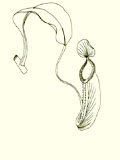

 |
 |
Miscellany (pdf)
Aeromonas and Vibrio spp. detected in Mai Po Nature Reserve and Inner Deep Bay
by Ji-Dong Gu and Yanling Wang
Mai Po and Inner Deep Bay Nature Reserve involve an area covering approximately 1,500 hectares, consisting of intertidal mudflats, mangroves, gei wai’s, fishponds and drainage channels. Each winter, between 49,000 to 68,000 water birds regularly stay at the site. Undoubtedly, this is the largest remaining wetland in Hong Kong and plays a very important role in supporting a wide range of wildlife including migratory birds and local important species like the blackfaced spoonbill. Since part of the intertidal wetland is on Shenzhen’s side of the Mainland China and the Shenzhen River also discharges a large quantity of wastewater into the Deep Bay Nature Reserve, protection of the ecological conditions of the area is an issue of regional importance for protection of wildlife and biodiversity. Microbial quality of the water and sediment in an area may also have a significant impact on wildlife. Recent findings suggest that fauna and migratory birds could be infected by microorganisms, particularly Aeromonas and Vibrio species occurring in polluted environments (Biscardi et al., 2002; Merrell et al., 2002).
An investigation was initiated to examine the current status of potentially harmful microorganisms in water and sediment samples of Mai Po and Inner Deep Bay. Both water and sediment were sampled, transported back to our laboratory immediately in a cooler, kept at 4° C and cultured for environmental Aeromonas and Vibrio spp. on selective culture media in February 2002. Among the water samples taken from four different locations of the Inner Deep Bay area, all were found positive for the presence of Aeromonas and Vibrio spp. Further detailed investigation indicated that between 25.9–100% of the samples collected tested positive for both microorganisms. Interestingly, water samples from two gei wai’s also showed positive results for the presence of Aeromonas and Vibrio spp. and 7.7–24.3% of the water samples were positive. In addition, sediment samples were also found positive for the two microorganisms and as high as 42.4-100% of the individual samples tested positive. It seems that the level of contamination is more serious in the Deep Bay area.
Isolation of these bacteria through enrichment culture on selective microbiological media could to be conducted in warmer months when the environmental temperatures are higher for positive recovery of these bacteria. Our detection of these bacteria as early as February strongly suggests that the Mai Po and Inner Deep Bay areas are seriously contaminated; detection of the opportunistic pathogen Aeromonas spp. and potentially pathogenic Vibrio spp. was unexpectedly high because the temperature at the sampling time in February is the lowest of the year and is not optimum for the growth of microorganisms. The positive results of water and sediment samples indicate that a large population of these microorganisms is residing in Mai Po Nature Reserve and Deep Bay, and represents a potential risk to migratory and local birds. As food source for water birds, both epifauna and infauna should be monitored for the extent of microbiological contamination.
Bibliography
Biscardi, D., Castaldo, A., Gualillo, O. & de Fusco, R. (2002) The occurrence of cytotoxic Aeromonas hydrophila strains in Italian mineral and thermal waters. The Science of the Total Environment 292: 255-263.
Merrell, D.S., Butler, S.M., Qadri, F., N. Dolganov, A., Alam, A., Cohen, M.B., Calderwood, S.B., Schoolnik, G.K. & Camilli, A. (2002) Host-induced epidemic spread of the cholera bacterium. Nature. 417: 642-645.
|
|
P.23 |
|
Porcupine! |
 Copyright © 2000 |